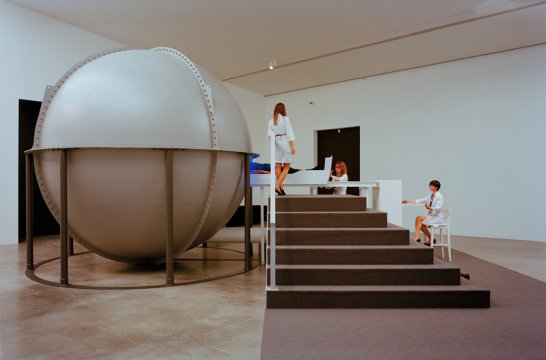"Schilling's work is a discourse on the anatomy of illusion. a return to the physical experience of perception. this work locates the visual experience in the brain by completing its visual text there. The art of Schilling opens up a critical dialogue between the arts. This view of art as a sense experience, as the convergence of the work and the perceiver, which brings the work into existence, establishes the basis of that experience as a means of deconstructing reality and constructing through that experience a path toward a renewal, and the opening up of the perceptual (sense) experience." John G. Hanhardt, Curator of Film and Video, Whitney Museum of American Art, New York 1977. Random Dot stereo works https://www.alfonsschilling.net/werke/randomdot-stereo/ http://www.vasulka.org/archive/Artists6/Schilling,Alphons/SchillingPoster2.pdf http://www.vasulka.org/archive/Artists6/Schilling,Alphons/ElectronicSpaces,etc.pdf An article discussing the
Tag: lit-rev
Carsten Holler / Olafur Eliasson
Carsten Holler is a key example within this study, often re- appropriating science for the purposes of art. Staging ‘Quasi-scientific’ experiments (Windsor, 2018) which transform the gallery into a laboratory. Often disorientating the viewer, or more appropriately, the participant. As well as the large-scale installations smaller performative works such as ‘Kit for Exploration of the Self’ (Carsten. Holler, 1995) take the form of durational perception changing instruments such as ‘Upside Down Glasses’ (Carsten Holler, 1994-2018). These both directly re-appropriate methods from experimental psychology (Stratton, 1896). Many of the works require the participant to travel through them or offer the opportunity to make decisions of which there are no return or unknown outcomes, further reinforcing this active notion of experience as
Augmented hands
‘Augmented hand series’ by Golan Levin, Chris Sugrue, and Kyle McDonald, 2013-2015) ‘MIRAGE Illusion Box’ (Roger Newport, 2008) These are two very similar projects which both transform the image of a hand in real time using Augmented Virtuality (AV, the digital manipulation of real-world objects). Both take the form of a black box, into which the hand is placed. When inside the participant can see their hand as if looking through a window into the box. Inside the box, a system of mirrors and motion tracking is used. An augmented or distorted digital image of the hand is relayed to a screen on the top of the box. Despite the technical similarities, both works stem from entirely different motivations. The ‘MIRAGE Illusion Box’ (Newport, 2018)
Be Another Lab
This International group interdisciplinary group adopt mechanisms employed in the cognitive sciences, such as the work of Mel Slater, and the arts. Their project ‘The Machine to Be Another’ allows anyone to experience a perspective from the body of an-other. The group speak of ‘expanding subjective experience’ and ‘understanding the relationship between identity and empathy from an embodied perspective’ (http://beanotherlab.org/) Using HMDs and live video, they have developed a number of critical applications. Investigating a wide range of issues including gender and disability. The group study the impact this work can have on people’s lives, employing methods of action research and co-creation. Be Another Lab embraces an open source approach. Sharing and developing their project through workshops, making the tools and
Labyrinth Psychotica
Labyrinth Psychotica is an artistic research project that aims to simulate the experience of psychosis. It uses multisensory [tactile and sonic] elements in combination with the maze environment, to create a fully immersive experience. The maze mechanism also serves as a metaphor for attempting to get inside the mind of another. The investigation aimed to not only portray an experience of psychosis but one that was ‘artistic’. It further asks if such an endeavour could prove ‘useful’. Though I can only speak from my experience of the work [1], it did seem effective in conveying elements of this experience, such as; loss of personal boundaries, and blurred borders between the body and space. Another element which resonates with Action Lab is the
The Multi-faceted body
A few notes from the BRnet Conference the Multi-faceted body. June 2018, Heriot-Watt University, Edinburgh, UK I felt strangely at home among so many research projects that use the hand as a model for the wider issues of body representation and ownership. Keynote speaker Mel Slater's talked about his playful and engaging research. Slater’s work centres around the idea of using immersive virtual reality as a medium to transform the self, not just the reality of a space. His research projects include self-help therapy. The project Personified Self Interaction (Osimo et al., 2015) allowed ‘you’ [embodied within an avatar of Freud] are able to talk to ‘yourself’ [an automated replay of you, embodied within an avatar of yourself] and vice-versa. This enables the
James Turrel – Light Reignfall
[vimeo 75419053 w=640 h=360] James Turrell's Light Reignfall @LACMA - Andrew van Baal James Turrell's Light Reignfall Light Reignfall is a work from his series of perceptual cells, inside the participant is exposed to a uniform homogenous field of modulated light. A combination of sensory overstimulation, yet deprived of recognisable forms or space, hallucinatory effects are experienced. “Assisted by an attendant, an individual viewer enters a spherical chamber on a sliding bed. A program of saturated light (operated by a technician) surrounds the viewer for twelve minutes, allowing the visitor to experience the intense, multi-dimensional power of light and the complex seeing instrument of the human eye.” "James Turrell (b. 1943, Los Angeles), a key artist in the Southern California Light and Space movement
